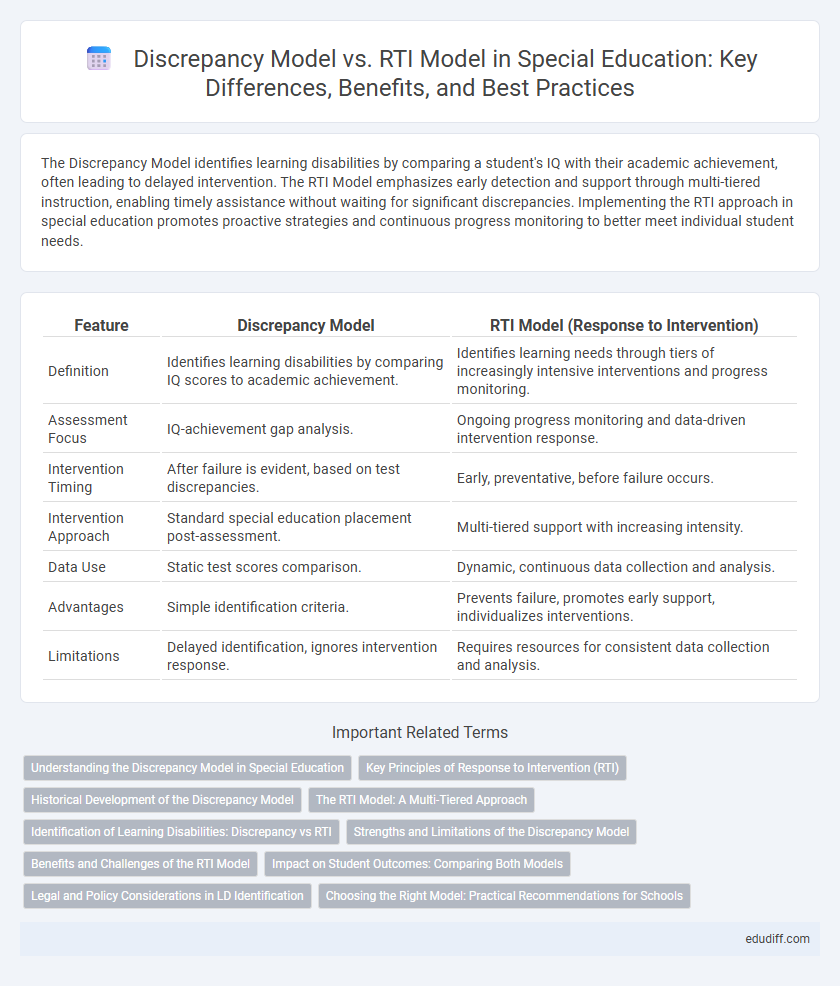The Discrepancy Model identifies learning disabilities by comparing a student's IQ with their academic achievement, often leading to delayed intervention. The RTI Model emphasizes early detection and support through multi-tiered instruction, enabling timely assistance without waiting for significant discrepancies. Implementing the RTI approach in special education promotes proactive strategies and continuous progress monitoring to better meet individual student needs.
Table of Comparison
| Feature | Discrepancy Model | RTI Model (Response to Intervention) |
|---|---|---|
| Definition | Identifies learning disabilities by comparing IQ scores to academic achievement. | Identifies learning needs through tiers of increasingly intensive interventions and progress monitoring. |
| Assessment Focus | IQ-achievement gap analysis. | Ongoing progress monitoring and data-driven intervention response. |
| Intervention Timing | After failure is evident, based on test discrepancies. | Early, preventative, before failure occurs. |
| Intervention Approach | Standard special education placement post-assessment. | Multi-tiered support with increasing intensity. |
| Data Use | Static test scores comparison. | Dynamic, continuous data collection and analysis. |
| Advantages | Simple identification criteria. | Prevents failure, promotes early support, individualizes interventions. |
| Limitations | Delayed identification, ignores intervention response. | Requires resources for consistent data collection and analysis. |
Understanding the Discrepancy Model in Special Education
The Discrepancy Model in special education identifies learning disabilities by comparing a student's intellectual ability with academic achievement to detect significant gaps. This model emphasizes early diagnosis through standardized IQ and achievement testing to guide individualized instruction. Critiques highlight its delayed intervention approach compared to Response to Intervention (RTI), which prioritizes continuous monitoring and support.
Key Principles of Response to Intervention (RTI)
The Response to Intervention (RTI) model emphasizes early identification and support through tiered instruction based on student responsiveness to interventions. Core principles include continuous progress monitoring, data-driven decision making, and the integration of evidence-based teaching practices to prevent academic failure. Unlike the Discrepancy Model, which relies on IQ-achievement gaps for diagnosing learning disabilities, RTI prioritizes real-time student performance to tailor interventions effectively.
Historical Development of the Discrepancy Model
The discrepancy model originated in the 1960s as a method for identifying learning disabilities by comparing a student's IQ score with their academic achievement, highlighting significant gaps. This model gained prominence due to its straightforward application but faced criticism over its overreliance on IQ tests and delayed intervention. As educational research advanced, the discrepancy model's historical limitations paved the way for the Response to Intervention (RTI) model, emphasizing early identification through continuous monitoring of student progress.
The RTI Model: A Multi-Tiered Approach
The RTI Model employs a multi-tiered system designed to provide targeted interventions at increasing levels of intensity to support students' learning and behavioral needs. Tier 1 includes high-quality classroom instruction for all students, while Tier 2 offers small group interventions for students who require additional support, and Tier 3 delivers individualized, intensive interventions. This structured approach facilitates early identification and prevention of learning difficulties, contrasting with the Discrepancy Model's reliance on significant achievement-cognitive ability gaps for special education eligibility.
Identification of Learning Disabilities: Discrepancy vs RTI
The Discrepancy Model identifies learning disabilities by highlighting a significant gap between a student's IQ and academic achievement, relying heavily on standardized testing scores. In contrast, the RTI Model focuses on early intervention, monitoring a student's response to targeted instruction to identify learning difficulties before significant gaps emerge. RTI's multi-tiered framework allows for ongoing progress monitoring, offering a dynamic approach to pinpoint students who require intensive support.
Strengths and Limitations of the Discrepancy Model
The Discrepancy Model excels in identifying significant gaps between a student's intellectual ability and academic performance, making it useful for diagnosing specific learning disabilities. However, it often delays intervention until a substantial gap emerges, potentially hindering early support. Critics argue the model lacks sensitivity to students with subtle learning difficulties and does not account for external factors influencing academic performance.
Benefits and Challenges of the RTI Model
The RTI (Response to Intervention) model offers significant benefits, such as early identification and support for struggling students through tiered interventions, which can reduce the need for special education referrals. Challenges include the requirement for continuous progress monitoring, professional development for educators, and ensuring fidelity in implementing interventions across diverse student populations. Despite these challenges, RTI promotes data-driven decision-making and individualized instruction that can enhance overall student outcomes.
Impact on Student Outcomes: Comparing Both Models
The Discrepancy Model, relying on IQ-achievement gaps, often delays intervention until significant academic failure occurs, negatively impacting timely student outcomes. In contrast, the RTI Model emphasizes early identification and continuous progress monitoring, leading to more proactive support and improved academic performance. Research indicates RTI's evidence-based interventions contribute to higher rates of student success and reduced special education placements.
Legal and Policy Considerations in LD Identification
The Discrepancy Model relies on identifying a significant gap between intelligence and academic achievement to diagnose learning disabilities, which often delays intervention and raises legal concerns about timely support under IDEA regulations. The RTI Model emphasizes early intervention through tiered instruction and continuous progress monitoring, aligning with policy mandates for prompt identification and reducing the risk of misidentification based on cognitive discrepancies. Legal frameworks increasingly favor RTI for its proactive approach, ensuring compliance with federal guidelines and enhancing equitable access to special education services.
Choosing the Right Model: Practical Recommendations for Schools
Schools should evaluate student needs, available resources, and intervention goals when choosing between the Discrepancy Model and the RTI Model for special education identification. The Discrepancy Model relies on identifying significant gaps between IQ and academic achievement, often delaying support, while the RTI Model emphasizes early, data-driven interventions through tiered instruction and monitoring. Implementing RTI can enhance timely support and reduce misidentification, but schools must ensure robust progress monitoring systems and professional training for effective execution.
Discrepancy Model vs RTI Model Infographic

 edudiff.com
edudiff.com